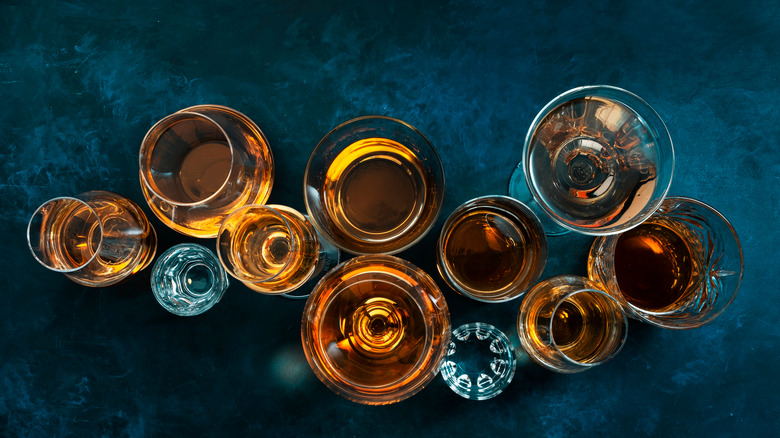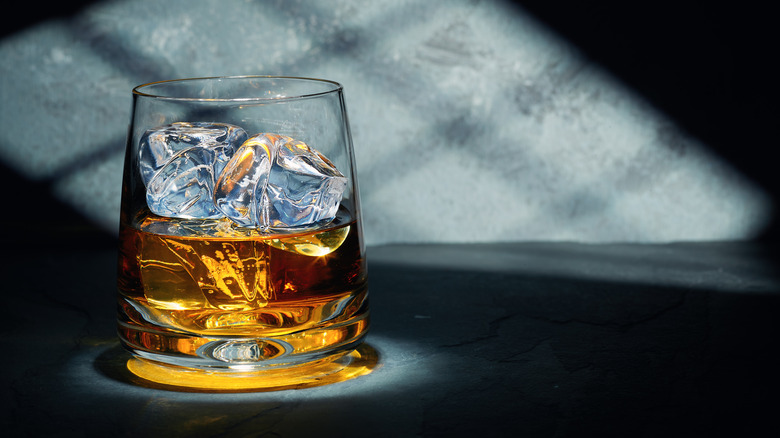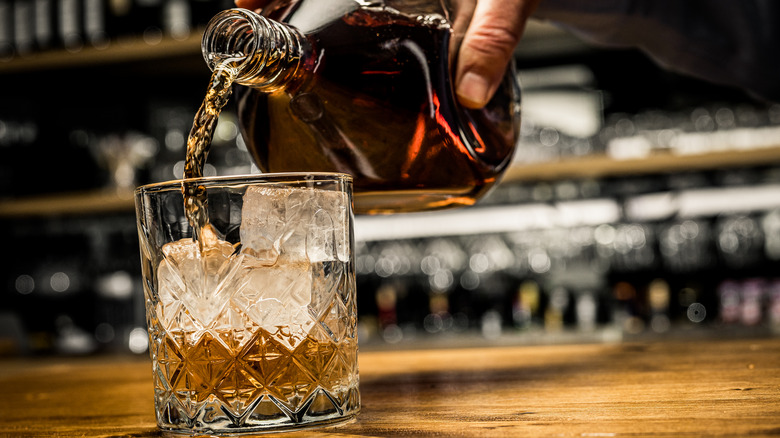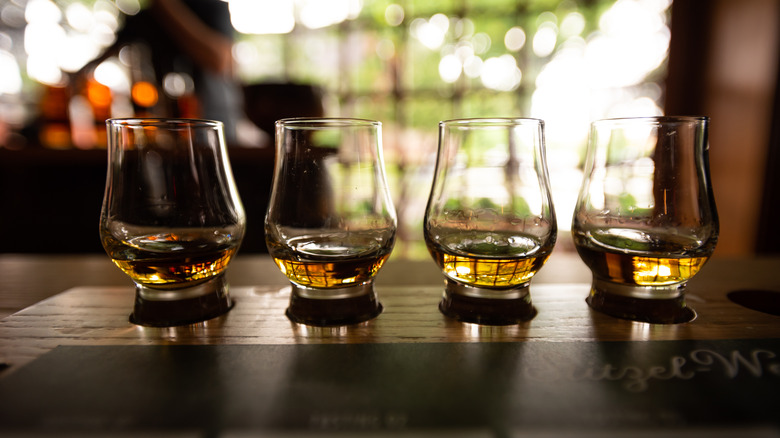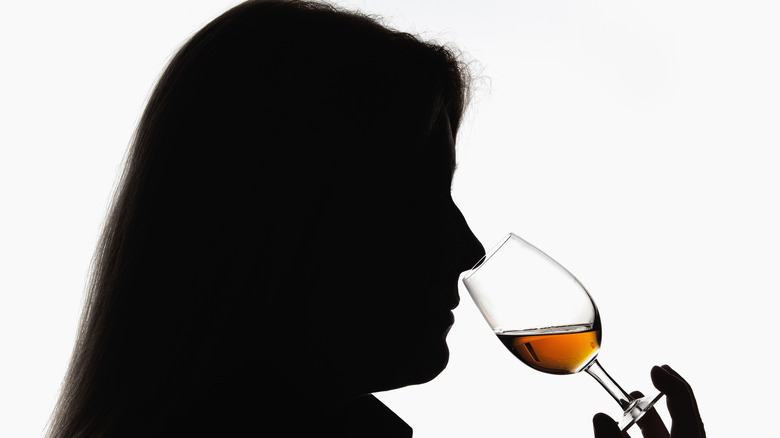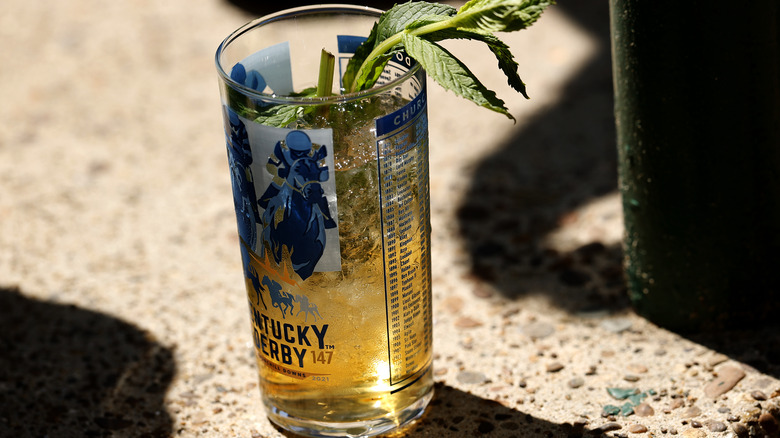The Difference Between High-Rye Bourbon And Rye Whiskey
Even for brown liquor aficionados, it can be difficult to distinguish between a high-rye bourbon and a rye whiskey, especially since bourbon falls under the whiskey umbrella. The two liquors look similar and are hard to tell apart based on smell. Even the taste can be similar if an equal amount of rye is used in each one. To the untrained eye these two liquors can seem interchangeable — they even typically feature the same alcohol content — but there are a few key distinctions that make high-rye bourbon and rye whiskey their own unique things, and these distinctions can be important factors in how you enjoy them.
High-rye bourbon is the less sweet counterpart of regular bourbon. Like other bourbon whiskeys, it can only be produced within the United States. The extra rye content of these bourbons gives them a spicier, peppery taste, but they still retain some of that traditional bourbon sweetness. In comparison, rye whiskey can be made anywhere in the world. It has a strictly spicy taste, evoking the flavors of baking spices like clove and cinnamon. What really differentiates these liquors, however, is their dominant grain. Both contain rye, as the names imply, but high-rye bourbon is still predominantly made from corn while rye whiskey is made from a minimum of 51% rye.
What is high-rye bourbon?
While bourbon is typically made with corn as the main grain, high-rye bourbon includes the addition of a significant amount of rye as well, hence the name. For a whiskey to be classified as a bourbon, it must be at least 51% corn. For high-rye bourbons, they also include around 20% rye. Typically, bourbons tend to be sweeter because of the high amount of corn present. The addition of rye in high-rye bourbon helps to balance out some of this sweetness. High-rye bourbon is described as being punchier than standard bourbon, meaning you get a stronger taste at first sip.
Like traditional bourbons, high-rye bourbon is made in new charred oak barrels, and the addition of rye makes for a dryer liquor. This means you get more prominent herbal, bitter tasting notes that aren't typically expected in bourbons. If you enjoy the taste of bourbon but are looking for something less sweet and more complex in flavor, a high-rye bourbon may appeal to you.
What is rye whiskey?
To be classified as a rye whiskey, the liquor must be made from at least 51% rye. Rye whiskeys are known for giving a spicy, slightly burning sensation when you drink them. This is because rye has a spicier flavor than other grains used for distilling. Some rye whiskeys will contain much more than 51% rye to give the whiskey an extra spicy kick. These whiskeys are going to feel sharp in your mouth due to their dry nature, making for a more dynamic mouth feel compared to bourbon and even high-rye bourbon.
Like bourbon and other whiskey varieties, rye whiskeys are aged in charred oak barrels, but rye whiskeys are allowed to be aged in pre-used barrels. The charred oak gives the liquor hints of vanilla sweetness and a pop of smokey wood flavor. Rye whiskey that's been aged longer features more prominent sweet notes, while younger rye whiskeys are heavy on the spice aspect. Either way, though, the sweetness will be minimal in a rye whiskey.
High-rye bourbons are mostly corn, rye whiskeys are mostly rye
While high-rye bourbons contain more rye than traditional bourbon whiskeys do, they are still mostly made up of corn. For a bourbon to be classified as such in the United States it must be made with 51% or more corn. According to New Riff Distilling, bourbon originated in Kentucky in the 1700s, when settlers used a mash mostly of corn to create the liquor. Due to the abundance of the crop in the United States, bourbon soon became the liquor of choice for many Americans. Corn gives bourbon whiskey its distinctly sweet flavor that people love. Corn also provides a smoother mouthfeel to the bourbon, making it easy to drink.
Rye whiskeys are distilled mostly from rye, which also became a popular choice for distilling in the 1700s and originated in Pennsylvania, according to Limestone Branch Distillery. Rye was easily grown in the climate and also provided a sharper flavor that was different from other whiskeys at the time, but its accessibility was a big selling point.
Only water can be added to high-rye bourbon, rye whiskey can have additives
Compared to other whiskeys, bourbon whiskeys have some of the strictest rules when it comes to classification. Bourbon whiskeys may not have any other additives used besides water. By law, nothing else can be used to alter the color, sweeten the bourbon, or enhance the flavor in any way. This process is in place to keep bourbon pure and offer clarity on the ingredients. This law was part of President Taft's Pure Food and Drug Act in 1906, according to Jeptha Creed Distillery. Though these strict requirements may seem silly, it's what has preserved authentic American bourbon for well over 100 years.
Rye whiskey, on the other hand, can feature additives if it is not labeled as "straight whiskey." Straight whiskey simply refers to whiskey that has no other additives — different types of whiskeys can be straight, including rye whiskeys. If a rye whiskey is not labeled as straight, though, up to 2.5% of the liquor could be additives. These additives can be used to bring a more uniform color to the whiskey or to bring out the tasting notes more. With heavy regulations in place, these additives don't alter the whiskey too much.
How to best enjoy high-rye bourbon and rye whiskey
Part of the appeal of a high-rye bourbon is that extra kick from the spicy rye. If you are drinking a high-rye bourbon to experience that intense flavor of the spice, you are probably best off enjoying this liquor neat. You can chill your glass and bourbon before pouring to get a little crispness from the cold. If you are worried about the spice feeling too intense for a bourbon, you can opt to drink it on the rocks; the addition of ice will help water down the intensity. A high-rye bourbon can also be a fun way to spice up a mint julep cocktail.
The resurgence of rye whiskey has brought on a new age of rye whiskey cocktails. Many classic whiskey cocktails such as the Manhattan and old fashioned would have featured strong rye whiskey flavors back in the times of their creation, so using rye whiskey for them today will get you closer to how these drinks were originally imagined. Rye whiskey can cut through the mixers of cocktails for a subtle edge. You could also go for rye whiskey neat or on the rocks if you want to fully experience the spice.
